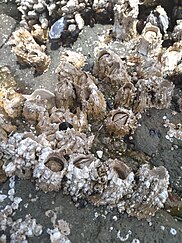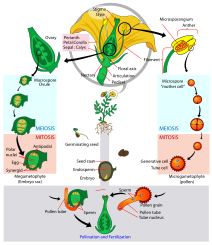Sexual system

A sexual system is a distribution of male and female function across organisms in a species.[1][2] Terms like reproductive system and mating system have also been used as synonyms.[3]
The distinction between sexual systems is not always clear due to phenotypic plasticity.[2] Sexual systems are viewed as a key factor for genetic variation and reproductive success, and may have also led to the origin or extinction of certain species.[4]
Interests in sexual systems go back to Darwin, who found that barnacles contain species that are androdioecious and some that are dioecious.[5]
Types of sexual systems

In
Mixed sexual systems are where hermaphrodites coexist with single sexed individuals.[7] This includes androdioecy, gynodioecy, and trioecy.[8]
What determines whether a flower is male, female, or hermaphroditic is the presence of a stamen — which contains male gametes — and/or pistil — which contains female gametes. Male (a.k.a. staminate) flowers only have a stamen. Female (a.k.a. pistillate) flowers only have a pistil. Hermaphrodite (a.k.a. perfect, or bisexual) flowers have both a stamen and pistil. The sex of a single flower may differ from the sex of the whole organism: for example, a plant may have both staminate and pistillate flowers, making the plant as a whole a hermaphrodite. Hence although all monomorphic plants are hermaphrodites, different combinations of flower types (staminate, pistillate, or perfect) produces distinct monomorphic sexual systems.[9]
(See Plant reproductive morphology for further details on plant sexual systems.)
List of sexual systems
| Sexual system | Description |
|---|---|
| Androdioecy | males and hermaphrodites coexist in a population.[10] It is rare in both plants and animals.[11] |
| Andromonoecy | rare sexual system in angiosperms, in which a plant has both male and hermaphroditic flowers.[12] It has been a subject of interest regarding the mechanism of sex expression.[13] |
Dichogamy |
an individual plant produces either exclusively male or exclusively female flowers at different points in time.[14] It is thought the temporal separation of producing male and female flowers occurs to prevent self-fertilization,[15] however this is debatable as dichogamy occurs in similar frequency among species which are self-compatible and self-incompatible.[16] |
Dioicy |
one of the two main sexual systems in bryophytes.[17] In dioicy male and female sex organs are on separate gametophytes.[18] |
| Dioecy | a species has distinct individual organisms that are either male or female, i.e., they produce only male or only female gametes, either directly (in animals) or indirectly (in plants).[19] |
| Gonochorism | individuals are either male or female.[19]
The term "gonochorism" is usually applied to animals while "dioecy" is applied to plants.[20] Gonochorism is the most common sexual system in animals, occurring in 95% of animal species.[21] |
| Gynodioecy | females and hermaphrodites coexist in the same population.[10] |
| Gynomonoecy | defined as the presence of both female and hermaphrodite flowers on the same individual of a plant species.[22] It is prevalent in Asteraceae but is poorly understood.[23] |
| Gynodioecy-Gynomonoecy | a sexual system for plants when female, hermaphrodite, and gynomonoecious plants coexist in the same population.[24]: 360 |
Monoicy |
one of the two main sexual systems in bryophytes.[17] In monoicy male and female sex organs are present in the same gametophyte.[18] |
Monoecy |
a sexual system in which male and female flowers are present on the same plant. It is common in angiosperms,[25] and occurs in 10% of all plant species.[26][dubious ] |
| Sequential hermaphroditism | individuals start their adult lives as one sex, and change to the other sex at a later age.[27] |
| Sequential monoecy | a confusing sexual system,[28] in which the combination of male, female, and hermaphrodite flowers presented changes over time.[29] For example, some conifers produce exclusively either male or female cones when young, then both when older.[30] Sequential monoecy can be difficult to differentiate from dioecy.[31] Several alternative terms may be used in reference to sexual systems involving temporal changes to sex presentation of a plant species (e.g. dichogamy, sequential hermaphroditism, sex change, paradioecy, diphasy).[32] |
| Simultaneous hermaphroditism | an individual can produce both gamete types in the same breeding season.[33] Simultaneous hermaphroditism is one of the most common sexual systems in animals (though far less common than gonochorism) and is one of the most stable.[34] |
| Synoecy | all individuals in a population of flowering plants bear solely hermaphrodite flowers.[27] |
| Trioecy | males, females, and hermaphrodites exist in the same population.[8] It is present in both plants and animals but is always extremely rare.[35] Trioecy occurs in about 3.6% of flowering plants.[36] Trioecy may infrequently be referred to as tridioecy.[37] |
| Trimonoecy | (also called androgynomonoecy) is when male, female, and hermaphrodite flowers are present on the same plant.[27][38] Triomonoecy is rare.[39] |
References
- ISBN 978-0-12-813252-4.
- ^ ISBN 978-3-319-94139-4.
- S2CID 91470660.
- S2CID 19562183.
- PMID 21881138.
- PMID 21219336.
- ISBN 978-0-19-532555-3.
- ^ ISSN 2296-7745.
- PMID 35050043.
- ^ ISBN 978-1-108-49985-9.
- ISBN 978-3-642-20763-1.
- PMID 22823201.
- ISBN 978-1-4200-0762-6.
- ISSN 0028-825X.
- PMID 25326608.
- PMID 30139145.
- ^ ISBN 978-1-4822-0133-8.
- ^ PMID 24180692.
- ^ ISBN 978-0-19-530761-0. Retrieved 2021-07-28.
- ISBN 978-0-12-800426-5.
- PMID 23970358.
- ISBN 978-0-19-860891-2.
- ISBN 978-3-03921-175-3.
- ISBN 978-3-319-25688-7.
- ISBN 978-1-4614-4915-7.
- ISBN 978-1-4008-3894-3.
- ^ ISBN 978-1-84246-604-9.
- ISBN 978-0-521-39250-1.
- PMID 23445824.
- S2CID 19890328.
- ISBN 978-0-521-25734-3.)
{{cite book}}: CS1 maint: multiple names: authors list (link - ISBN 978-0-19-802192-6.
- ISBN 978-3-319-94139-4.
- ISBN 978-0-19-532555-3.
- ISBN 978-3-319-94139-4.
- PMID 24246889.
- S2CID 254468003.
- ISBN 978-0-7329-4439-1.
- S2CID 13226982.
